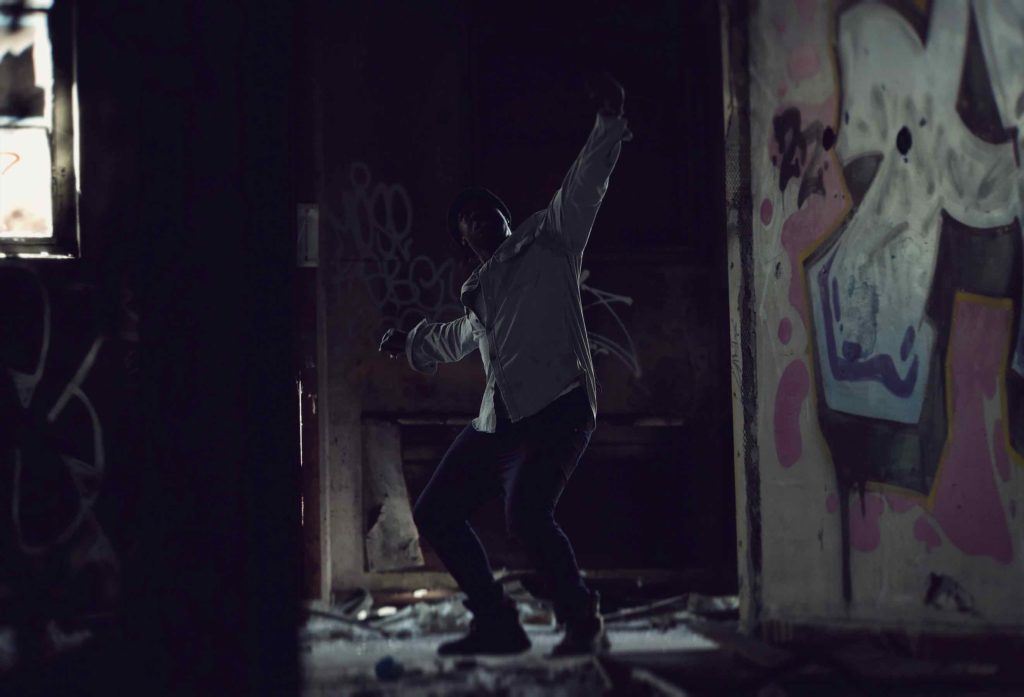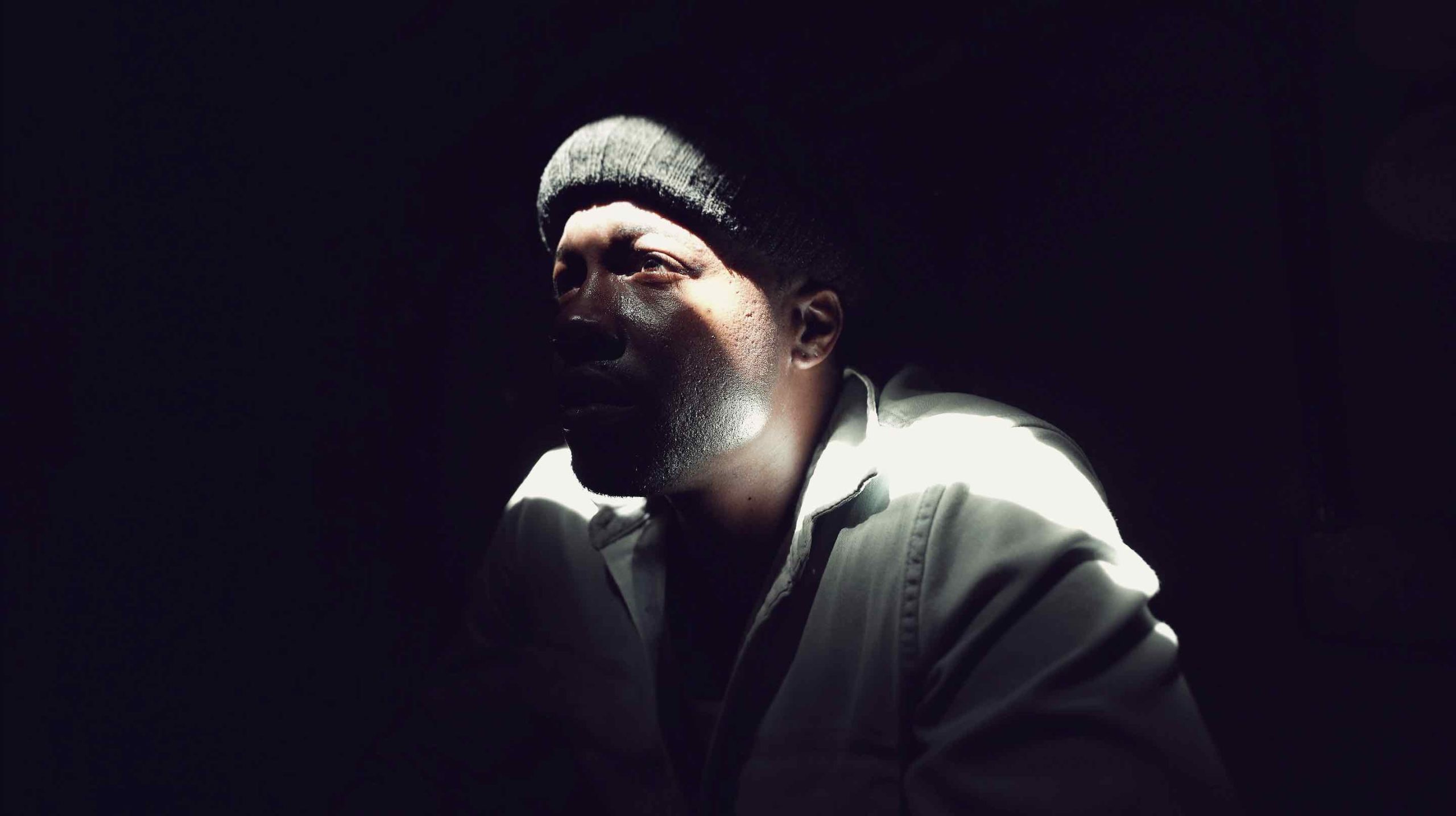Photo by Antwan Williams
[ID: Close up image of Maurice sitting in a dark room, representing his most challenging times during his incarceration. Seen from an angle, only part of his face and shoulders are illuminated by a stark bright light. He is looking slightly upwards and wears a collared shirt and a black beanie.]
I survived 13 years in prison, but I am not free from my experience of prison. I have nightmares of being thrown back into the system. I am hyper vigilant, often secluded, and wake up most days still amazed that I am not incarcerated. Every second of every day, I accept that my reality consists of the version of me that is free, and the version of me that will never be free.
I find myself torn between perspectives. One perspective tells me that I am living out my God-given right to freedom, will and agency. Simultaneously, I am thinking about how lucky I am to have been given a second chance at life.
Freedom has been packaged and purchased by most people in America as a divine right, something of the highest value. Currently and formerly incarcerated people know it to be a luxury, a privilege. What does that say about the mindset of those impacted by the carceral system?
***
One of my mentors, long-time teacher, and friend, Amie Dowling, presented me and three other people – Reyna Brown, Tiersa Nureyev and Maurice Reed—with an opportunity to collaborate on work that is meaningful and true to who we are as artists. With no hesitation, I agreed. We had no clear vision or idea about what we wanted to create, but we each trusted the process. With time and space, art develops and challenges your thoughts, your understanding of self, and your lived experience. The one thing we were clear on is that this project was going to be centered around our close friend Maurice Reed who was released from San Quentin State Prison a few months earlier after also serving 13 years.
Maurice and I decided to find a place to start filming and talking through our experiences of being thrown back into a world that we had become strangers to.
And in that moment of uncertainty, we drove to Mare Island in Vallejo, California, where there is open parking, land and trails. We noticed that where we parked fit the aesthetics of a prison. Tall buildings that look unattended, fences, locked gates, thick yellow lines that outline unauthorized areas, police cars, security guards making rounds like clockwork, dirt, dust, and silence that could either be eerie or peaceful depending on places you have been.

[ID: In a dark abandoned building, Maurice dances with stretched arms continuing the story of reaching for new heights while being in a place that feels empty, alone, and deprived. Moving in an area that has been still and silent for years.]
In prison yards there are “Mac Shacks,” shacks where you can check out recreational gear: basketballs, handballs, footballs, soccer balls, jump ropes, horseshoes, and even chess boards. It’s also where correctional officers are sometimes posted. For people fortunate enough never to have experienced that, imagine a big brown toll booth only to fit one or two people.
Directly in front of where Maurice and I parked, there stood a “Mac Shack.” This is where the project must begin.
Maurice sat in front of the Mac Shack. There lay a long empty road between him and me, and it felt like he was awaiting someone’s arrival. Fingers interlaced, elbows on knees, sun settling behind him, and time continuing to pass. Sitting side by side with someone with whom I served almost eight years felt so natural and surreal. This long strip of empty road reminiscent of the concrete slabs we would walk day and night. We started reliving moments of our incarceration where we fantasized about being in the exact moment we were actually in—marveling at the journey, mourning the parts of ourselves still behind those walls, yellow lines, locked gates, and caged cells monitored by officers and security like clockwork.
Time, freedom, new life, a fresh start. These were some of the concepts we decided to explore. We presented our ideas to our other team members, Tiersa Nureyev and Reyna Brown, and knew their input would help guide the project and sculpt the vision.
We explored cities, places, spaces, styles of dance, types of movements, poetry, music, wardrobe, props, and self. As formerly incarcerated people, we had to explore profound truths about prison that we still carry in our bodies: The gravity of being removed from society for over a decade. Our tattoos, injuries, memories, unprocessed traumas, survivor guilt.
In the height of the COVID-19 pandemic Maurice recalls like clockwork voices near and far screaming and pleading for assistance when another incarcerated person fell ill, “MAN DOWN, MAN DOWN, MAN DOWN! Some people came back to the cells, and some didn’t. You would get word that someone else passed away.”

[ID: On a long, endless road, Maurice (dressed in all black) seems stuck on a highway he no longer wants to be on. With one knee and one hand planted and his other leg stretched to the side, he reaches for the sky while connecting to the ground.]
The goal of this piece is to both express and challenge. Express truth from our perspective and challenge those who face what we create. How do we express the reality of confinement that is unique and honest? How do we highlight the cycles created by institutions to keep people in the same conditions they have always been in? How do we creatively say, “I am one of the millions of men and women who deserve a second chance or access to their God-given right to freedom?” How do we show how beautiful life is while remembering the decrepit structures we and others have been housed in?
By creating a duality in Maurice’s performance we show the various stages Maurice was in throughout his incarceration. Some movements are harder and faster; some moves are slower and more restrictive. His relationship to the space changes his movement.
We decided to have an hourglass representing the prison structure, the overpacked conditions, time, and the people who are trapped and may never get out. We understand that prison possesses a power that can turn people’s worlds upside down at a moment’s notice. And those that live within those structures are forced to adjust and adapt while still fighting to pass through the door to freedom. We are privileged in the eyes of those still serving their sentences, while understanding that freedom is not just a concept or an idea. It is an act of agency that extends beyond cells, locked gates, yellow lines, and prison walls. It extends beyond ankle monitors and a fifty-mile radius that keeps people monitored. Freedom extends beyond our future and reaches into our past. Addressing all of our truths and challenging us in a way that makes you face a version of you that you didn’t even know existed. Freedom offers you the opportunity to restructure your mind. That is a challenge that Maurice and I have been addressing in this project and in our own lives.
When I was incarcerated, I wanted the freedom to create in prison, be it dance, music, paintings, or drawings. Then I wanted my freedom. Once I was paroled, I thought I was free. Until freedom showed up as a desire to be off parole. Once I got off parole and became a completely free man, I realized I wasn’t free from the nightmares of my experiences in prison or the anxiety I felt when I was around someone in law enforcement.
Amie Dowling, Reyna Brown, Tiersa Nureyev, Maurice Reed, and I have been unpacking this idea of freedom that we have all bought into—making room for a new look at freedom.
While doing this project, one thing has become clear: the carceral system can only confine those it encounters. It can never give someone freedom. We have to give that to ourselves every second of every day from this point on.

[ID: Maurice looks directly into the camera. In the foreground, his hand is blurred with his fingers splayed as he reaches forward. Facing a new reality, Maurice fights to connect with a world he has been apart from for 13 years.]
This article appeared in the Fall 2022 issue of In Dance.


